Searing fish using parchment paper
Parchment paper is a cellulose-based composite that has been processed to give it additional properties including non-stickiness and grease resistance, A classic and simple use of parchment paper is to steam fish en papillote (or inside parchment paper wrappings.
Using parchment paper has become an easy and very effect way to sear fish especially salmon. It does produce a very crispy skin... a few notes though. While parchment paper is heat-resistant, it is not fireproof. It should not be exposed to direct flames, so the parchment paper must be cut to fit directly in a stainless steel pan.
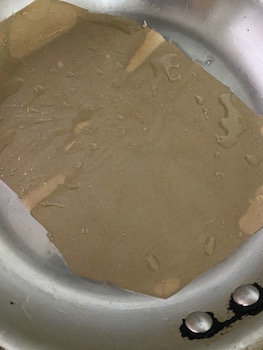
Parchment paper with oil under and on top
Method
1) Cut a piece of parchment paper to just fit in a stainless steel pan. This method works best with a stainless steel pan since the pan will get hotter.
2) Season the fish with salt and pepper on the flesh side only.
3) Dry the skin by scraping a knife along the skin an patting completely dry with a paper towel.
4) Check the temperature of the oil (pan) using an infrared thermometer. When you are near the smoke point add the fish skin side down. We used grapeseed oil for this process since it has a high smoke point and a neutral flavor.
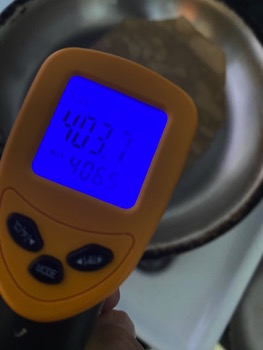
5) After adding the fish press down with your fingers to prevent curling of the fish.
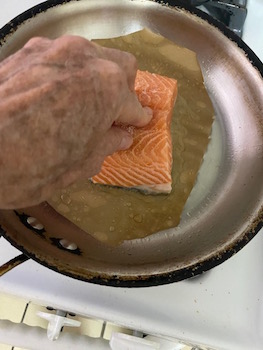
6) Let fish sear skin side down till internal temperature is 120F. Check skin side to see if proper sear... if not continue cooking.
7) Note: We checked the temperature after 4 minutes and recorded a very high temperature of
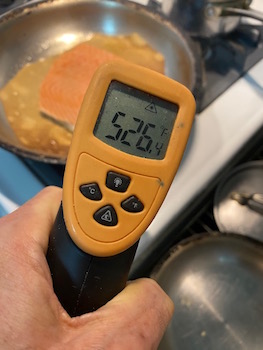
This is a very high temperature where omega-3 oil and grapeseed oil will break down to toxic molecules. See: Profiling of Omega-Polyunsaturated Fatty Acids and Their Oxidized Products in Salmon after Different Cooking Methods
8) Flip the fish and turn off flame... cook till desired internal temperature.
9) Because of oxidized products take fish and rest on a paper towel skin side down and do not use any liquid products left in pan!!
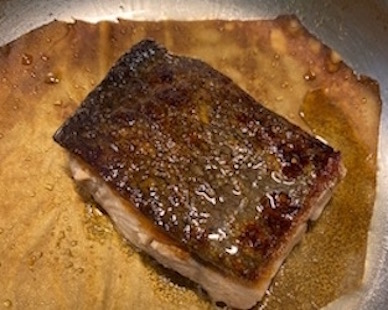
9) Let rest on paper towel for 2 minutes to help drain oils
Searing Using Stainless Steel without Parchment Paper
The same temperature was found without parchment paper. Much care however had to be taken to prevent salmon from sticking-- drying very carefully the skin before searing and heating the oil. The skin was found to be very crispy although it appeared that skin was slightly more crispy using parchment paper
Searing using Non-stick Pan
The temperature of the grapeseed oil reached the same 520F using non stick. The fish was added at 420F
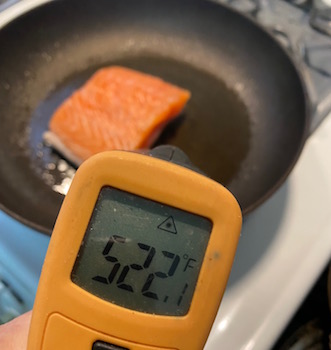
The sear was comparable but again we found the parchment paper to be the crispiest
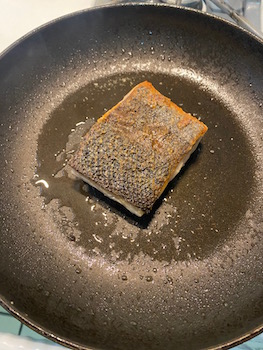
About Smoke Point and Temperature reached during this Searing
"...Smoke point of an oil is not a constant throughout cooking, and it can change as the oil breaks down. The best measure of a cooking fat’s properties is oxidative stability...Grapeseed Oil Easily Oxidizes During Heat Exposure...Before heat exposure, grapeseed oil already contained more than 1% trans fats. Exposure to 240°C heat resulted in the formation of more trans fats." source
| OIL | SMOKE POINT |
| Avocado Oil | 520F 270C |
| Safflower Oil | 510F 265C |
| Peanut Oil | 450F 232C |
| Sunflower Oil | 440F 227C |
| Grapeseed Oil | 420F 216C |
| Extra Virgin Olive Oil | 410F 210F |
Effect of Temperature on Omega-3 Fatty Acids
Salmon is considered one of the healthiest fish since it is high in protein and omega-3 fatty acids (EPA and DHA) that provide well documented benefits for the heart and brain.
"... The main omega-3 fatty acids, EPA and DHA, were significantly degraded, even at 50 °C. Their relative concentrations decrease from 6.1% for EPA and 4.1% for DHA to 1.7% and 1.5% after degradation at 150 °C, respectively. On the other hand, the relative concentrations of monounsaturated and saturated fatty acids remained constant or slightly increased by a few percent after degradation (e.g., from 10.7% to 12.9% for palmitic acid). .." from Thermal and oxidative stability of Atlantic salmon oil (Salmon salar L.) and complexation with β-cyclodextrin
Science of Cooking
See also:
Science of cooking with brown butter
How to prevent ice crystals from forming in sorbet Taste Molecules --
Science of Chocolate
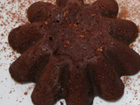
NEWScience of Chocolate How is Chocolate Made?
What are the health benefits of Chocolate?
What are the drugs in Chocolate?